Table of Contents
THE CONTEXT: India is the world’s fifth largest economy and the prospect of steady progress in the coming years is bright. Here, the critical role played by infrastructure in economic growth cannot be overemphasized. Investing in high-quality infrastructure is crucial for accelerating economic growth and sustaining it in the long run. This chapter covers the recent and past experiences of the government in transforming and inter-locking the potential of physical, regulatory and digital infrastructure.
- The correlation between infrastructure and development brings us to the present scenario when during the times of pandemic and geo-political crisis, the government kept its focus on reforms in areas of physical, digital and regulatory infrastructure.
- In order to increase the private sector participation in creation of new infrastructure and development of existing ones, the government took initiatives like Public-Private Partnership (PPP), National Infrastructure Pipeline (NIP) and National Monetisation Pipeline (NMP).
- In addition to this, as part of the structural reforms with the objective to enhance efficiencies and cost competitiveness, Gati Shakti and National Logistics Policy (NLP) were launched.

- Reflecting on the journey of digital infrastructure growth and its global adoption, it is pertinent to mention that in 2009, only 17 per cent of adults in India had bank accounts, 15 per cent used digital payments, 1 in 25 had a unique ID document, and about 37 per cent had mobile phones.
- These numbers have seen a meteoric rise — tele density has reached up to 93 per cent, over a billion people have a digital ID document, more than 80 per cent have bank accounts, and as of 2022, over 600 crore of digital payment transactions are completed per month.
- India is able to offer many best practices, particularly with respect to its digital infrastructure innovations, that can be emulated globally. Successful vaccination drive through the one-stop Co-WIN portal, DigiLocker, Open Network for Digital Commerce (ONDC), Open Credit Enablement Network (OCEN), Goods and Services Tax (GST) Sahay are a few success stories among many.
GOVERNMENT’S VISION AND APPROACHES TO INFRASTRUCTURE DEVELOPMENT IN INDIA
- The government, in recent years, provided an increased impetus for infrastructure development and investment through the enhancement of capital expenditure.
- This push has happened at a time of crisis when the capital expenditure by the private sector has been subdued. The outlay (target) for capital expenditure in 2022-23 (BE) was increased sharply by 35.4 per cent from ₹ 5.5 lakh crore in the previous year (2021-22) to ₹ 7.5 lakh crore, of which approximately 67 per cent has been spent from April to December 2022.
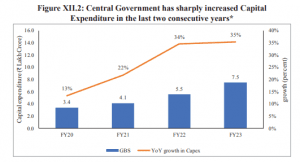
PUBLIC-PRIVATE PARTNERSHIPS (PPPS)
- Private participation in infrastructure programmes supports several PPP models, including management contracts like Build-Operate-Transfer (BOT), Design-Build-FinanceOperate-Transfer (DBFOT), Rehabilitate-Operate-Transfer (ROT), Hybrid Annuity Model (HAM), and Toll-Operate-Transfer (TOT) model. Under the BOT model, there are two variants – BOT (Toll) and BOT (Annuity) depending on who bears the traffic risk. In the case of BOT (Toll), the traffic risk is borne by the PPP concessionaire, while in the case of BOT (Annuity), it is borne by the public authority.
- The Public Private Partnership Appraisal Committee, the apex body for appraisal of PPP projects, has cleared 79 projects with a total project cost of ₹2,27,268.1 crore from FY15 to FY23.
NATIONAL INFRASTRUCTURE PIPELINE (NIP)
- The government launched the National Infrastructure Pipeline (NIP) with a forward-looking approach and with a projected infrastructure investment of around ₹111 lakh crore during FY20-25 to provide high quality infrastructure across the country.
- The NIP currently has 8,964 projects with a total investment of more than ₹108 lakh crore under different stages of implementation.
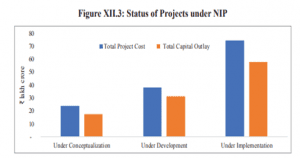
NATIONAL MONETIZATION PIPELINE – CREATION THROUGH MONETIZATION
- The National Monetization Pipeline (NMP) was thus announced on 23 August 2021. Based on the principle of ‘asset creation through monetization’, it taps private sector investment for new infrastructure creation.
- The NMP provides an opportunity for deleveraging balance sheets and providing fiscal space for investment in new infrastructure assets.
- The top 5 sectors (by estimated value) capture around 83 per cent of the aggregate pipeline value: roads (27 per cent) followed by railways (25 per cent), power (15 per cent), oil & gas pipelines (8 per cent), and telecom (6 per cent). Roads and railways together contribute around 52 per cent of the total NMP value.
- Against the monetization target of ₹0.9 lakh crore in FY22, ₹0.97 lakh crore have been achieved during the period under roads, power, coal and mines.
NATIONAL LOGISTICS POLICY: REDUCING THE COST OF LOGISTICS
- Logistics costs in India have been in the range of 14-18 per cent of GDP against the global benchmark of 8 per cent.
- Many efforts have already been made by the Government of India to improve the logistics ecosystem through ‘infrastructure initiatives’ such as Ude Desh ka Aam Nagrik (UDAN), Bharatmala, Sagarmala, Parvatamala, National Rail Plan, and through ‘process reforms’ GST, e-Sanchit, Single Window Interface for Trade (SWIFT), Indian Customs Electronic Data Interchange Gateway (ICEGATE), Turant Customs, and others.
- National Logistics Policy (NLP) was launched on 17 September 2022, addressing the components of improving efficiency in logistics through streamlining processes, regulatory framework, skill development, and mainstreaming logistics among others. The Policy will be implemented through a Comprehensive Logistics Action Plan (CLAP).
- The targets for achieving the vision of the NLP are to-
- reduce the cost of logistics in India to be comparable to global benchmarks by 2030.
- improve the Logistics Performance Index ranking – endeavour is to be among the top 25 countries by 2030.
- create a data driven decision support mechanism for an efficient logistics ecosystem.
LEADS (Logistics Ease Across Different States) index:
- Government undertook a survey-based assessment of logistics ease in various States and UTs in the form of the LEADS index in 2018 to gauge their logistics ecosystem. It was followed by surveys in 2019, 2021, and 2022.
- It is based on a stakeholders’ survey and uses the World Bank’s Logistics Performance Index (LPI) methodology.
- LEADS 2022 has adopted a classification-based grading, and States have been now classified under four categories viz., coastal States, hinterland/ landlocked States, North-Eastern States, and UTs for the assessment of how well a State or UT has performed in comparison to the top State/UT within the specific cluster.
- Taking a break from the past, states have not been ranked in order. This time, they have been allotted three performance categories, namely, Achievers: States/UTs achieving a percentage score of 90 per cent or more, Fast Movers: States/UTs achieving percentage scores between 80 to 90 per cent, and Aspirers: States/UTs achieving percentage scores below 80 per cent.
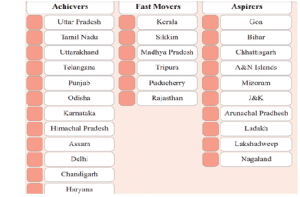
PM GATI-SHAKTI: A MASTER PLAN FOR INTEGRATED PROJECT PLANNING
- The growth experience of advanced economies has highlighted the importance of having a multimodal transport network approach.
- Introducing the holistic planning in the case of infrastructure projects, the government launched PM GatiShakti, charting a transformative approach to infrastructure development.
- PM GatiShakti National Master Plan creates comprehensive database for integrated planning and synchronized implementation across Ministries/ Departments.
- It aims to improve multimodal connectivity and logistics efficiency while addressing the critical gaps for the seamless movement of people and goods.
DEVELOPMENTS IN PHYSICAL INFRASTRUCTURE SECTORS
Road Transport: Increased budgetary support by the government augmented road connectivity.
- There has been an increase in the construction of National Highways (NHs)/roads over time, with 10,457 km of roads constructed in FY22 as compared to 6,061 km in FY16. In FY23 (until October 2022), 4,060 km of NHs/roads were constructed, which was around 91 per cent of the achievement in the corresponding period of the previous financial year.
- Total budgetary support for investment in the sector has been increasing rapidly in the last four years and stood at around ₹1.4 lakh crore during FY23 (as of 31 October 2022).
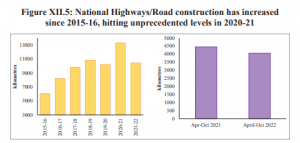
Railways: Expansion and modernization, a continuous process
- The Indian Railways (IR), with over 68,031 route kms, is the fourth largest network in the world under single management.
- The capital expenditure (Capex) on infrastructure in railways has received tremendous boost since 2014. It has seen a continuous increase in the last four years with Capex (B.E.) of ₹2.5 lakh crore in FY23, up by around 29 per cent compared to the previous year.
- During the last eight years (2014-22), 30,446 Route Kilometres (RKM) have been electrified compared to an electrification of 4,698 RKM during the previous eight-year period, a more than six-fold increase.

Civil Aviation: Revival backed by domestic demand
- While in FY21, there was a considerable decline in the air-traffic (a decline of 54 per cent) as well as passenger traffic handled (a decline of 66 per cent), FY22 saw a recovery, mainly led by the domestic sector. The current financial year has further shown a rebound, with both passenger and cargo movement close to the pre-Covid-19 levels.
- Schemes such as UDAN, which has considerably enhanced regional connectivity through the opening of airports in India’s hinterland.
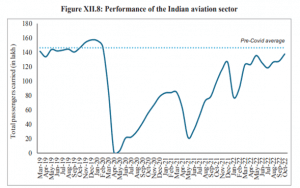
Ports: Handling higher capacity with governance reforms
- The development of ports is crucial for the economy, given that most of the international trade is handled through ports (around 90 per cent of international trade cargo by volume and 79.9 per cent by value). The capacity of major ports, which was 871.5 Million Tonnes Per Annum (MTPA) at the end of March 2014, has increased to 1534.9 MTPA by the end of March 2022. Cumulatively they handled 720.1 MT traffic during FY22.
Inland Water Transport: Tapping the potential of navigable waterways
- Inland water transport holds great untapped potential as a means for the transportation of goods and passengers. India has a large endowment of rivers, canals, and other waterways. The total navigable length of waterways in India is around 14,850 kilometres.
- Under the National Waterways Act 2016, 106 new waterways have been declared as National Waterways (NWs), taking the total number of NWs in the country to 111.

Electricity: Installed capacity growth driven by renewables
- The total electricity generated, including that from captive plants during the year FY22 was 17.2 lakh GWh as compared to 15.9 lakh GWh during the FY21, of which 14.8 lakh GWh was generated by utilities and 2.3 lakh GWh in captive plants.
- Thermal sources of energy make up the largest (59.1 per cent) share of total installed capacity in utilities, followed by renewable energy resources with 27.5 per cent and hydro with 11.7 per cent.
DEVELOPMENTS IN DIGITAL INFRASTRUCTURE
- The government’s Digital India programme, which aims to transform India into a digitally empowered society and knowledge economy, envisions digital infrastructure as a core utility to every citizen.
Telecommunications: Accelerating provision of affordable services
- The total telephone subscriber base in India stands at 117 crore (as of November 2022). While more than 97 per cent of the total subscribers are connected wirelessly (114.3 crore at the end of November 2022), 83.7 crore have internet connections as of June 2022. The overall tele-density in India stood at 84.8 per cent, with wide differences across states. It ranged from 55.4 per cent in Bihar to 270.6 per cent in Delhi.
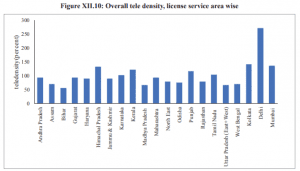
- With a special focus on the states in the North-Eastern Region, the government is implementing a Comprehensive Telecom Development Plan (CTDP).
- A comprehensive initiative to connect our islands to the mainland has been realized through the government’s initiative of the Comprehensive Telecom Development Plan for Islands.
- A landmark achievement in telecommunications in India was the launch of 5G services. 5G could impact consumers directly through higher data transfer speeds and lower latency.
- As a major reform measure, the Indian Telegraph Right of Way (Amendment) Rules, 2022, will facilitate faster and easier deployment of telegraph infrastructure to enable speedy 5G rollout.
- Universal and equitable access to broadband services across the country, especially in rural areas, is an important part of the government’s vision for national digital connectivity.
Growth Story of Digital Public Infrastructure
- The emergence of Digital Public Infrastructure (DPI), aimed at improving financial literacy, innovation, entrepreneurship, employment generation, and empowering beneficiaries has played a critical role in uplifting the economy and bringing it to the stature where it stands today.
- A lack of knowledge about the existing schemes was seen as a primary reason behind the beneficiaries’ inability to access the schemes’ benefits. ‘MyScheme’ is an e-Marketplace for schemes where users can look for suitable schemes based on their eligibility.
- The scheme acts as the single national platform for launching any government scheme. As on 16 January, 2023, more than 181 Central and State/UT government schemes across 14 diverse categories have been hosted on the portal.
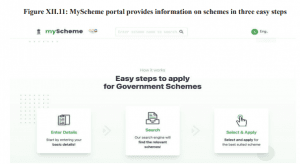
- To reduce the search cost for the commoners, the government launched Unified Mobile Application for New-Age Governance (UMANG), which enables citizens to access e-Government services offered by the Central and State Government in various sectors such as agriculture, education, health, housing, employees, pensioners, and students’ welfare, the Public Distribution System, and others.
- Until 16 January 2023, UMANG catered to about 21,869 services (1,672 Central and State Govt. services and 20197 Bill Payment services) under 310+ departments of Central Government and departments of 34 States/UTs. Over 4.9 crore users are registered and benefiting from services on UMANG.
- While the initiatives mentioned above focused on bringing the government to the doorsteps of the citizens, a unique initiative that deserves special mention is the Open Network for Digital Commerce (ONDC).
- Another important domain that the government has emphasized is the availability of open resources on Artificial Intelligence (AI). The national AI portal has been developed with a view to strengthening the AI ecosystem in the country.
- The government has also taken initiatives towards empowering individuals with control over their data to access essential services related to finance, health, education, and skills digitally.
- The Account Aggregator (AA) is a global techno-legal framework that enables individuals to share their financial data quickly and securely, with their consent, with any regulated third-party financial institution of their choice. The AA framework is currently live across over 110 crore of bank accounts.
- India is geared to strengthen the up-and-coming drone industry. Under Mission ‘Drone Shakti’, the drone start-ups and Drone-as-a-Service (DrAAS) are being promoted.
- As our digital space widens to bring in newer services, the need for appropriate regulations becomes paramount.
THE CONCLUSION: Today, we are operating in the new normal where the global economy is still recovering from the setback due to pandemic, and geo-political conflicts persist. India could effectively steer through the situation owing to its dedicated support to infrastructure creation through increased capex and strong macroeconomic fundamentals. But, with the advent of new technologies, we are witnessing new regulatory challenges. Technology and innovation are, per se, neither constructive nor destructive. The use cases present the positive aspects of technology and innovation. The synergy between physical and digital infrastructure will be one of the defining features of India’s future growth story.
Spread the Word
